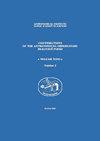等级恒星系统中的紧密双星
IF 0.2
4区 物理与天体物理
Q4 ASTRONOMY & ASTROPHYSICS
Contributions of the Astronomical Observatory Skalnate Pleso
Pub Date : 2020-04-06
DOI:10.31577/caosp.2020.50.2.448
引用次数: 3
摘要
许多(但不是全部)紧密二进制是三重和高阶层次系统中的内部对。紧密双星和等级系统之间的统计关系已经很好地建立起来。虽然紧密双星可以通过Kozai-Lidov旋回与潮汐的结合形成,但Moe & Kratter(2018)的研究表明,只有一小部分可以通过这种机制产生,许多紧密双星甚至在恒星收缩到主序之前就形成了。没有观测到潮汐形成的预测统计特征,例如潮汐截止点以下的周期积累。相反,紧密双星形成的主要渠道可能是吸积驱动的迁移。紧密的双星和三星之间的关系不是偶然的,它源于吸积强度这一共同因素。高吸积产生了大质量的恒星,这些恒星有很大一部分是紧密的双星,同时也有很大一部分是等级系统。本文章由计算机程序翻译,如有差异,请以英文原文为准。
Close binaries in hierarchical stellar systems
Many (but not all) close binaries are inner pairs in triple and higherorder hierarchical systems. The statistical relation between close binaries and hierarchical systems is well established. Although close binaries can form by a combination of Kozai-Lidov cycles with tides, the study of Moe & Kratter (2018) indicated that only a fraction of them could be produced by this mechanism and that many close binaries form even before stars contract onto the main sequence. The predicted statistical signatures of tidal formation, such as accumulation of periods just below the tidal cutoff, are not observed. Instead, the main channel of close-binary formation is likely accretion-driven migration. The relation between close binaries and triple stars is not casual, it derives from the common factor which is the accretion strength. High accretion creates massive stars that have a large fraction of close binaries and, at the same time, a large fraction of hierarchical systems.
求助全文
通过发布文献求助,成功后即可免费获取论文全文。
去求助
来源期刊
CiteScore
1.10
自引率
20.00%
发文量
4
审稿时长
>12 weeks
期刊介绍:
Contributions of the Astronomical Observatory Skalnate Pleso" (CAOSP) is published by the Astronomical Institute of the Slovak Academy of Sciences (SAS). The journal publishes new results of astronomical and astrophysical research, preferentially covering the fields of Interplanetary Matter, Stellar Astrophysics and Solar Physics. We publish regular papers, expert comments and review contributions.

 求助内容:
求助内容: 应助结果提醒方式:
应助结果提醒方式:


